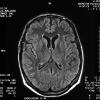Gadolinium enhancement of cauda equina: a new MR imaging finding in the radiculitic form of tick-borne encephalitis
- PMID: 16687530
- PMCID: PMC7975728
Gadolinium enhancement of cauda equina: a new MR imaging finding in the radiculitic form of tick-borne encephalitis
Abstract
Tick-borne encephalitis virus is an important human pathogen in Europe. The infection usually presents as meningitis, meningoencephalitis, or meningoencephalomyelitis and only rarely as symptoms of isolated myeloradiculitis. We describe the lumbar MR imaging finding in a 48-year-old man with serologically confirmed tick-borne encephalitis in which there was enhancement of the ventral surface of the conus and the anterior nerve roots from the T12 level extending along the length of the ventral cauda.
Figures


References
-
- Kaiser R. The clinical and epidemiological profile of tick-borne encephalitis in southern Germany 1994–98: a prospective study of 656 patients. Brain 1999;122:2067–78 - PubMed
-
- Haglund M, Günther G. Tick-borne encephalitis-pathogenesis, clinical course and long-term follow-up. Vaccine 2003;21:S1/11–S1/18 - PubMed
-
- Kollmeier M, Hagemann G, Kunze A, et al. Problems of differential diagnosis in tick-borne encephalitis-induced polyradiculitis. Nervenarzt 2002;73:1191–94 - PubMed
-
- Marjelund S, Tikkakoski T, Tuisku S, et al. Magnetic resonance imaging findings and outcome in severe tick-borne encephalitis: report of four cases and review of the literature. Acta Radiol 2004;45:88–94 - PubMed
-
- Waldvogel K, Bossart W, Huisman T, et al. Severe tick-borne encephalitis following passive immunization. Eur J Pediatr 1996;155:775–79 - PubMed
Publication types
MeSH terms
Substances
LinkOut - more resources
Full Text Sources
Medical
